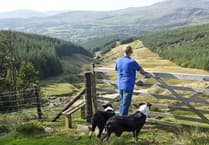The year 2030 is not far away. There’s a target of having 30 per cent of land and 30 percent of our seas protected by then in order to increase biodiversity and definitely halt current losses. Wales is nowhere near reaching the 30 by 30 target. Although the Welsh Government (WG) has committed to this, the chair of the Climate Change, Environment, and Infrastructure Committee, MS Llyr Gruffudd, argues in their report, “Given the current state of Wales’ nature, meeting this commitment will be an extraordinary challenge.”
On reading the report it struck me how reliant the WG seems to be on existing protected areas like Sites of Special Scientific Interest (SSSIs) and Special Areas of Conservation (SACs) to reach the 30 percent target. For Wales to reach this vital goal, it’s essential that farmers play a huge part. The Sustainable Farming Scheme (SFC) was supposed to come into force in 2025 but was delayed till 2026 last year. That is an election year and I foresee plenty of electoral wrangling that will put off the date of implementation. Plus it’s bound to be watered down enormously or even abandoned by new politicians in power.
Why is it that the WG keeps not taking farmers with them? I‘ve looked at some schemes in other parts of the world and struggle to understand why in our wealthy country we cannot get this sorted.
All over Africa people, but especially farmers, have to live alongside dangerous predators. Lions were on the path to extinction but farmers are helping to bring them back from the brink. As Sara Evans, author of ‘When the Last Lion Roars’, says, “Lions are benefitting from the tolerance demonstrated by many pastoralist communities who share the land with them.”
In India small-scale farmers – most have less than 1 hectare - are proud to help the Sarus cranes nest in their fields. This species, listed as Vulnerable by the International Union for the Conservation of Nature, would be extinct now if all traditional farmland had been transformed into large mechanised concerns.
Closer to home in Scotland farmers are joining forces to make their land more resilient to flooding and burning, both increasingly occurring due to our altering climate. Nearly 100 farms and estates have formed the Northwoods Rewilding Network. This network has been set up specifically for smaller-scale farmers. Their nine principles include: increasing native woodland, recreating wilder rivers, having more space for water, establishing wildlife corridors, letting nature lead, and connecting with communities.
The urgency with which we need to approach policies in Wales is exemplified by the massive decrease in insect populations. I remember clouds of craneflies and butterflies as a child, cockchafers bouncing off the walls and moths of every colour. Reading the depressing statistics on the number of butterflies should be enough for politicians and farmers to realise they need to get round the table and reach an agreement. The Centre for Ecology and Hydrology reports, “Newly released data has shown that 2024 was one of the worst years on record for butterflies in the UK. More than half of butterfly species in the UK are now in long-term decline and over a third are showing significant declines.”
Contributors to the WG Committee highlighted the critical role of the SFC in supporting nature recovery. WWF Cymru said the Scheme “is likely to become the most significant intervention point for combined nature and climate action for Welsh Government for years to come.” Similarly, Plant Life said, “Encouraging nature friendly farming practices through [the Scheme] could be the biggest tool to deliver on biodiversity in Wales.” What are we waiting for?





Comments
This article has no comments yet. Be the first to leave a comment.